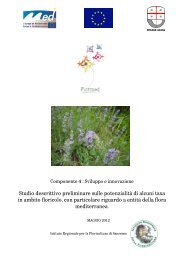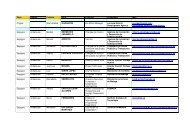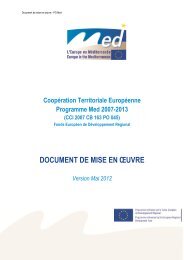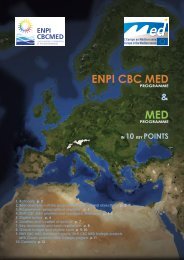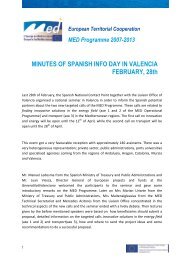MED Communication Handbook - Programme Med
MED Communication Handbook - Programme Med
MED Communication Handbook - Programme Med
Create successful ePaper yourself
Turn your PDF publications into a flip-book with our unique Google optimized e-Paper software.
This factsheet runs through the fundamental concepts and skills that good<br />
journalists use to write powerful and effective prose. Many of these ideas are<br />
universal and can be applied to all kinds of writing, from press releases and case<br />
studies to project internal correspondence.<br />
Planning and preparing<br />
Audience<br />
There is no such thing as simply good writing. Writing is only good if it gets the<br />
right message across to a specific audience. An article full of scientific detail and<br />
jargon might be perfect for an academic journal, but useless for a community<br />
magazine. Therefore, a writer’s first step must be to identify the intended<br />
readership. Audience analysis determines the tone, style, pitch, angle and content<br />
of every article. It determines what knowledge can be assumed and what needs to<br />
be explained. It determines what news angles will work. Write what your audience<br />
wants to read, in a way that will interest and appeal to them. A good writer always<br />
keeps that audience at the front of his or her mind from the very start.<br />
Messages<br />
What key information do you want to communicate? Narrow it down to two or three<br />
basic messages that will form your theme. Build the article around these messages<br />
using evidence, quotes and colour. Messages can be explicit (clearly stated as<br />
information) or implicit (intended for subliminal or emotional impact). For instance,<br />
an article about <strong>MED</strong> <strong>Programme</strong> project may contain explicit messages about the<br />
scheme itself, and the implicit message that pan-European cooperation is valuable<br />
and positive. Messages sit alongside audiences at the heart of the writing process.<br />
Research<br />
Good writing requires thorough research and knowledge of the subject matter,<br />
which should be clear to the reader through those same three building blocks:<br />
evidence, quotes and colour. Gather and organise these materials before starting to<br />
write. Be sure to have evidence to back up all of your main statement, in the form<br />
of recent statistics or official information, and cite sources to give credibility to your<br />
arguments. Check your facts.<br />
Organisation<br />
After determining your audiences, your messages and a strong news angle to tie<br />
them all together, it can help to organise your information systematically. Wellwritten<br />
prose alternates between statement and quote, between numbers and<br />
colour. It gradually unfolds, with copy flowing logically between elements, so that<br />
the end of each sentence announces the beginning of the next.<br />
2<br />
� Factsheet 11: Writing Skills<br />
�



